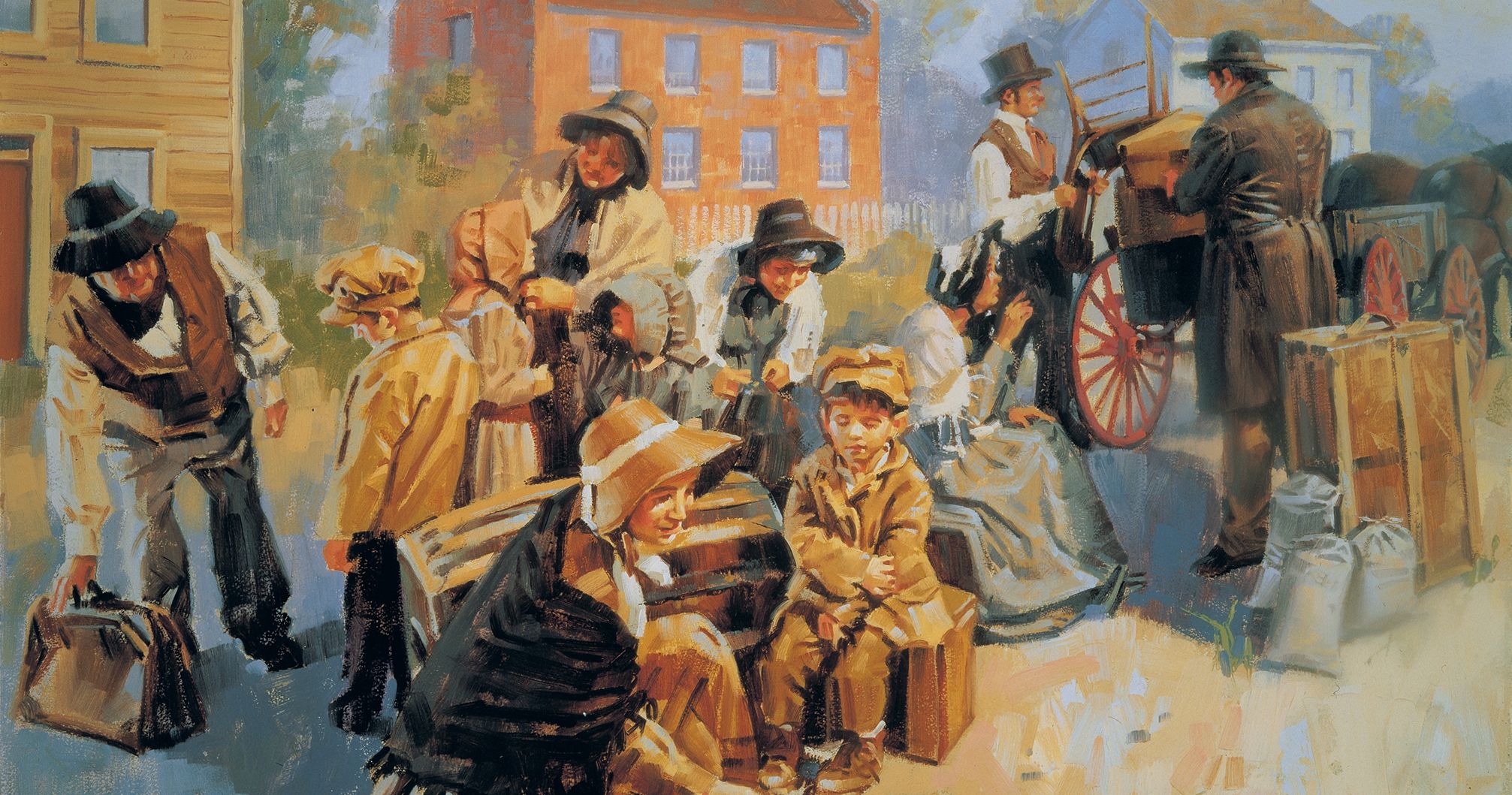You are here
Book of Mormon Central is in the process of migrating to our new Scripture Central website.
We ask for your patience during this transition. Over the coming weeks, all pages of bookofmormoncentral.org will be redirected to their corresponding page on scripturecentral.org, resulting in minimal disruption.

D&C 37–40
New from BMC
Watch videos from Gospel scholars and teachers to learn more about these sections of the Doctrine and Covenants. Book of Mormon Central produces weekly videos from Tyler Griffin, Taylor Halverson, John Hilton III, Anthony Sweat, Casey Griffiths, Stephanie Dibb Sorensen and Marianna Richardson. Read commentaries and other resources from KnoWhys, Steven C. Harper, Casey Griffiths, and Susan Easton Black.
Overview
Doctrine and Covenants 37
Doctrine and Covenants 38
Doctrine and Covenants 39
Doctrine and Covenants 40
Daily Reading Plan
Structure your personal scripture study by following a 15-minute, day-by-day plan. Each day's assignment includes the required scripture passages from the Come, Follow Me curriculum, as well as suggestions for additional resources to bring context and understanding to your study. For the best experience, use our Reading Plan in the free ScripturePlus app! You can track your progress and have access to the best resources.
Monday
- Commentary: Section 37 Context, Steven C. Harper
- Scripture: D&C 37:1–4
- Commentary: Section 38 Context, Steven C. Harper
- Scripture: D&C 38:1–9
Tuesday
- Scripture: D&C 38:10–20
-
Commentary: Doctrine and Covenants 38:13–22 could be called the covenant of the gathering. As the Savior did in past ages of the world, He gives a new covenant to the Saints (D&C 38:20), promising them blessings if they obey His commandments and a land of promise where they can gather and know peace. The Lord made similar covenants with the Israelites (Deuteronomy 11:8–9) and the children of Lehi (2 Nephi 1:5). The most detailed account of this covenant is given in the writings of Abraham where the Lord promised “to make of thee a minister to bear my name in a strange land which I will give unto thy seed after thee for an everlasting possession, when they hearken to my voice” (Abraham 2:6).
As with His promise to Abraham, the Lord’s promise to the Saints of a land of inheritance was only the beginning of a holistic covenant that blesses every man and woman who enters into it. Some of the promised blessings require administration in a dedicated house of God, the first of which in the latter days would be built by the Saints who gathered to Kirtland. The Lord promised Abraham, “I will make of thee a great nation, and I will bless thee above measure, and make thy name great among all nations, and thou shalt be a blessing unto thy seed after thee, that in their hands they shall bear this ministry and Priesthood unto all nations” (Abraham 2:9).
The Lord’s initial promise to the Saints involved land, as did His promise to Abraham, but the ultimate aim was that the land given to Abraham’s posterity, which includes the Saints, would bring the blessings of God unto all the nations of the earth. President Russell M. Nelson outlined the blessings of the Abrahamic covenants, including the blessing of a promised land, as follows: “The covenant God made with Abraham (Genesis 17:1–10, 19) and later reaffirmed with Isaac and Jacob (Leviticus 26:42) is of transcendent significance. It contained several promises, including:
Jesus the Christ would be born through Abraham’s lineage.
Abraham’s posterity would be numerous, entitled to an eternal increase, and also entitled to bear the priesthood.
Abraham would become a father of many nations.
Certain lands would be inherited by his posterity.
All nations of the earth would be blessed by his seed.
And that covenant would be everlasting—even through “a thousand generations.” (Deuteronomy 7:9)
President Nelson also declared, “Some of these promises have been fulfilled; others are still pending. I quote from an early Book of Mormon prophecy: ‘Our father [Lehi] hath not spoken of our seed alone, but also of all the house of Israel, pointing to the covenant which should be fulfilled in the latter days; which covenant the Lord made to our father Abraham’ (1 Nephi 15:8). Isn’t that amazing? Some 600 years before Jesus was born in Bethlehem, prophets knew that the Abrahamic covenant would be finally fulfilled only in the latter days.”
Casey Paul Griffiths, Doctrine and Covenants Minute, Doctrine and Covenants 38:13–22. - Video: God's Introduction - Taylor Halverson (D&C 38)
Wednesday
- Scripture: D&C 38:21–27
-
Commentary: While diversity and tolerance are correctly celebrated among the Saints today, these virtues must also be balanced in harmony with the blessings of unity. As the work of the Lord grows and moves into different nations and cultures, the unity of the Saints throughout those cultures is a key element of our strength and capacity to bless those around us. President Howard W. Hunter counseled,
Within this Church there is a constant need for unity, for if we are not one, we are not his (see D&C 38:27). We are truly dependent on each other, “and the eye cannot say unto the hand, I have no need of thee: nor again the head to the feet, I have no need of you” (1 Cor. 12:21). Nor can the North Americans say to the Asians, nor the Europeans to the islanders of the sea, “I have no need of thee.” No, in this church we have need of every member, and we pray, as did Paul when he wrote to the church in Corinth, “that there should be no schism in the body; but that the members should have the same care one for another.
President Hunter continued,
As we think of the great growth of the Church, the diversities of tongues and cultures, and the monumental tasks that yet lie before us, we wonder if there is any more important objective before us than to so live that we may enjoy the unifying spirit of the Lord. As Jesus prayed, we must be united if the world is ever to be convinced that he was sent by God his Father to redeem us from our sins.
It is unity and oneness that has thus far enabled us to bear our testimony around the globe, bringing forward tens of thousands of missionaries to do their part. More must be done. It is unity that has thus far enabled the Church, its wards and stakes, branches and districts, and members, to construct temples and chapels, undertake welfare projects, seek after the dead, watch over the Church, and build faith. More must be done. These great purposes of the Lord could not have been achieved with dissension or jealousy or selfishness. Our ideas may not always be quite like those who preside in authority over us, but this is the Lord’s church and he will bless each of us as we cast off pride, pray for strength, and contribute to the good of the whole.”
Casey Paul Griffiths, Doctrine and Covenants Minute, Doctrine and Covenants 38:23–27. - Video: What Was the Gathering - Casey Griffiths (D&C 37-40)
Thursday
- Scripture: D&C 38:28–38
-
Commentary: Here the Lord provides the “why” behind the purpose of the gathering: first to give unto the Saints His law and then to endow them with power from on high (D&C 38:32). The law came in a revelation given in February 1831, now canonized as Doctrine and Covenants 42. The law included a collection of laws directing and governing the Church, among them the beginnings of the law of consecration (D&C 42:30–42). The second part of the commandment is essentially the beginning of the restoration of temple ordinances in the latter days.
The endowment of power intended for the Saints was associated with the central purpose of the gathering. Joseph Smith later taught,
What was the object of gathering the Jews, or the people of God in any age of the World? . . . The main object was to build unto the Lord a house whereby he could reveal unto his people the ordinances of his house and the glories of his kingdom, and teach the people the way of Salvation, for there are certain ordinances and principles that when they are taught and practiced must be done in a place or house built for that purpose. It was the design of the Councils of heaven before the world was, that the principles and Laws of the Priesthood were predicated upon the gathering of the people in every age of the world. . . . It is for the same purpose that God gathers together his people in the last days to build unto the Lord a house to prepare them for the ordinances and endowments washings and anointings.”
Casey Paul Griffiths, Doctrine and Covenants Minute, Doctrine and Covenants 38:28–33. - KnoWhy 290: Where Did Joseph Smith Get His Ideas about the Physical and Spiritual Gathering of Israel?
Friday
- Scripture: D&C 38:39–42
- Commentary: Section 39–40 Commentary, Steven C. Harper
- Scripture: D&C 39:1–6
- Video: A Heart That Is Always Right - John Hilton III (D&C 39-40)
Saturday
- Scripture: D&C 39:7–18
- Bio: James Covill, Susan Easton Black
-
Commentary: James eventually rejected the call from the Lord to teach and gather with the Saints to the Ohio. As was the case with James, no person is forced to accept callings or commandments from God; they always have the power to reject them. In response to the question, “Do we really need to obey all of God’s commandments?” Elder Dieter F. Uchtdorf answered, “I think God knows something we don’t—things that are beyond our capacity to comprehend! Our Father in Heaven is an eternal being whose experience, wisdom, and intelligence are infinitely greater than ours. Not only that, but He is also eternally loving, compassionate, and focused on one blessed goal: to bring to pass our immortality and eternal life. In other words, He not only knows what is best for you; He also anxiously wants you to choose what is best for you.”
Elder Uchtdorf continued,
Part of our challenge is, I think, that we imagine that God has all of His blessings locked in a huge cloud up in heaven, refusing to give them to us unless we comply with some strict, paternalistic requirements He has set up. But the commandments aren’t like that at all. In reality, Heavenly Father is constantly raining blessings upon us. It is our fear, doubt, and sin that, like an umbrella, block these blessings from reaching us. . . . His commandments are the loving instructions and the divine help for us to close the umbrella so we can receive the shower of heavenly blessings.”
James Covel, in making the choice not to comply with the Lord’s commandments, deprived himself of the shower of blessings the Lord intended to provide for him. Rather than punishing him, the Lord instead was unable to provide the promised blessings to James because he refused to take the actions necessary to receive them. In another discourse, Elder Uchtdorf explained, “Faith is powerful, and often it does result in miracles. But no matter how much faith we have, there are two things faith cannot do. For one, it cannot violate another person’s agency . . . God will invite, persuade. God will reach out tirelessly with love and inspiration and encouragement. But God will never compel—that would undermine His great plan for our eternal growth.”
Casey Paul Griffiths, Doctrine and Covenants Minute, Doctrine and Covenants 39:7–14.
Sunday
- Scripture: D&C 39:19–24
-
Commentary: In the last part of this revelation, the Lord reiterates the promises made to the Saints who choose to gather to the Ohio. He also emphasizes one other purpose of the gathering—to bring the people to safety before the time of His return to earth. The Savior says that those who receive the gift of the Holy Ghost will be “be looking forth for the signs of my coming, and shall know me” (D&C 39:23). Being aware of the signs of the Savior’s coming is one of the Savior’s commands to his disciples in the last days. In an 1839 discourse, Joseph Smith taught,
I will prophecy that the signs of the coming of the Son of man are already commenced, one pestilence will desolate after another. We shall soon have war and bloodshed [and] the moon will be turned to blood. I testify of these things and that the coming of the Son of man is nigh, even at your very doors. If our souls and our bodies are not looking forth for the coming of the Son of man and after we are dead if we are not looking forth we shall be among those who are calling for the rocks to fall upon us.”
At the same time, it is possible to become imbalanced in our approach toward the signs of the time. When this revelation was given, the signs of the Savior’s coming consisted essentially of Doctrine and Covenants 29, 38; Matthew 24; Mark 13; the book of Revelation; 1 Nephi 21; 3 Nephi 21–22; and Mormon 8. Further information about the signs of the Second Coming would come in Doctrine and Covenants 45, 87, 101, and 133. In an era in which we are flooded with constant information and speculation about the signs it is still good counsel to keep our search for the signs closely aligned to the words of God found in the scriptures or given to modern prophets.
Casey Paul Griffiths, Doctrine and Covenants Minute, Doctrine and Covenants 39:15–24. - Scripture: D&C 40:1–3
-
Quote: Many of us place ourselves in circumstances far more consequential than embarrassment because of our procrastination to become fully converted to the gospel of Jesus Christ. We know what is right, but we delay full spiritual involvement because of laziness, fear, rationalization, or lack of faith. We convince ourselves that “someday I’m going to do it.” However, for many “someday” never comes, and even for others who eventually do make a change, there is an irretrievable loss of progress and surely regression.
As a partial self-appraisal of our spiritual-procrastination standing, what is our attitude when we attend the meetings of the Church? Is it to learn “by study and also by faith” which seamlessly translates what we learn into what we do? Or do we have an “I’ve heard it all before” mentality that immediately blocks the Spirit’s access to our minds and our hearts and enables procrastination to become a major part of our character?
Of a prominent early investigator of the restored Church, who covenanted that he would obey any command that the Lord would give him, it was said, “And he received the word with gladness, but straightway Satan tempted him; … and the cares of the world caused him to reject the word.” Contrast that with the Lord’s clear statement: “He that receiveth my law and doeth it, the same is my disciple.”
Donald L. Hallstrom, “Do It Now,” October 2007 General Conference.
Bibliography
Doctrine and Covenants 37
Steven C. Harper, “Section 37,” Doctrine and Covenants Contexts (Springville, UT: Book of Mormon Central, 2021), 78–79.
Susan Easton Black, “The Doctrine of Gathering,” in Restoration Voices Volume 2: Insights and Stories of the Doctrine and Covenants (Springville, UT: Book of Mormon Central, 2021).
Elizabeth Maki, “'Go to the Ohio',” Revelations in Context: The Stories Behind the Sections of the Doctrine and Covenants. Salt Lake City, UT: The Church of Jesus Christ of Latter-day Saints, 2016.
Ronald D. Dennis, "Gathering," in Encyclopedia of Mormonism, ed. Daniel H. Ludlow (New York, NY: Macmillan Publishers, 1992): 2:536–537.
“Gathered In,” Saints, Volume 1: The Standard of Truth (Salt Lake City, UT: The Church of Jesus Christ of Latter-day Saints, 2018), 1:109–111.
“After Much Tribulation,” Saints, Volume 1: The Standard of Truth (Salt Lake City, UT: The Church of Jesus Christ of Latter-day Saints, 2018), 1:126–127.
Doctrine and Covenants 38
Steven C. Harper, “Section 38,” Doctrine and Covenants Contexts (Springville, UT: Book of Mormon Central, 2021), 80–82.
Susan Easton Black, “'Go to the Ohio',” in Restoration Voices Volume 2: Insights and Stories of the Doctrine and Covenants (Springville, UT: Book of Mormon Central, 2021).
Elizabeth Maki, “'Go to the Ohio',” Revelations in Context: The Stories Behind the Sections of the Doctrine and Covenants. Salt Lake City, UT: The Church of Jesus Christ of Latter-day Saints, 2016.
Scott C. Esplin, “Why the Ohio? Why Anything in My Life? Lessons from the Command to Gather,” Religious Educator 10, no. 3 (2009): 175–188.
“After Much Tribulation,” Saints, Volume 1: The Standard of Truth (Salt Lake City, UT: The Church of Jesus Christ of Latter-day Saints, 2018), 1:126–127.
“Endowment of Power,” Church History Topics.
D&C 38:9
Sharon Anderson, “Like Joshua,” in The Glory of the Son (Orem, UT: Time-Lines Etc., 2019), 20.
D&C 38:18
Sharon Anderson, “Passage to the Promised Land,” in The Glory of the Son (Orem, UT: Time-Lines Etc., 2019), 74.
D&C 38:21
Sharon Anderson, “Types and Shadows,” in The Glory of the Son (Orem, UT: Time-Lines Etc., 2019), 23.
D&C 38:22
Sharon Anderson, “Among the Reeds,” in The Glory of the Son (Orem, UT: Time-Lines Etc., 2019), 15.
D&C 38:27
Sharon Anderson, “Prayer for the Prophet,” in The Glory of the Son (Orem, UT: Time-Lines Etc., 2019), 70.
D&C 38:32–33
Book of Mormon Central. “Where Did Joseph Smith Get His Ideas about the Physical and Spiritual Gathering of Israel? (2 Nephi 21:11).” KnoWhy 290 (March 22, 2017).
D&C 38:39
Book of Mormon Central, “How Can People Today Avoid Being Destroyed Like the Nephites Were? (Helaman 13:5–6),” KnoWhy 327 (June 16, 2017).
Book of Mormon Central, “Why Does the Book of Mormon Warn Against Seeking after Riches? (Jacob 2:18),” KnoWhy 518 (May 30, 2019).
Book of Mormon Central, “Why Did the “Pride Cycle” Destroy the Nephite Nation? (3 Nephi 6:10),” KnoWhy 195 (September 26, 2016).
D&C 38:42
Book of Mormon Central, “Why Did Moroni Refer to Vessel Impurity in Condemning the Central Government? (Alma 60:23),” KnoWhy 169 (August 19, 2016).
Doctrine and Covenants 39
Steven C. Harper, “Section 39–40,” Doctrine and Covenants Contexts (Springville, UT: Book of Mormon Central, 2021), 83–85.
Susan Easton Black, “Stay the Course,” in Restoration Voices Volume 2: Insights and Stories of the Doctrine and Covenants (Springville, UT: Book of Mormon Central, 2021).
Susan Easton Black, “James Covill,” in Restoration Voices Volume 1: People of the Doctrine and Covenants (Springville, UT: Book of Mormon Central, 2021).
Jed Woodworth, “James Covel and the 'Cares of the World',” Revelations in Context: The Stories Behind the Sections of the Doctrine and Covenants. Salt Lake City, UT: The Church of Jesus Christ of Latter-day Saints, 2016.
Christopher C. Jones, “Mormonism in the Methodist Marketplace: James Covel and the Historical Background of Doctrine and Covenants 39-40,” BYU Studies Quarterly 51, no. 1 (2012): 67–98.
“Zion/New Jerusalem,” Church History Topics.
Book of Mormon Central. “What Did the Early Saints Learn about the Second Coming from the Book of Mormon? (3 Nephi 29:2).” KnoWhy 318 (May 26, 2017).
D&C 39:1–3
Book of Mormon Central, “What Can We Learn from the Savior’s First Words at Bountiful? (3 Nephi 11:10-11),” KnoWhy 341 (July 19, 2017).
D&C 39:13
Book of Mormon Central, “Why Does Zion Flourish in the Wilderness? (1 Nephi 2:2),” KnoWhy 362 (September 7, 2017).
Sharon Anderson, “How Far,” in The Glory of the Son (Orem, UT: Time-Lines Etc., 2019).
Doctrine and Covenants 40
Steven C. Harper, “Section 39–40,” Doctrine and Covenants Contexts (Springville, UT: Book of Mormon Central, 2021), 83–85.
Susan Easton Black, “Rejecting the Word of God,” in Restoration Voices Volume 2: Insights and Stories of the Doctrine and Covenants (Springville, UT: Book of Mormon Central, 2021).
Jed Woodworth, “James Covel and the 'Cares of the World',” Revelations in Context: The Stories Behind the Sections of the Doctrine and Covenants. Salt Lake City, UT: The Church of Jesus Christ of Latter-day Saints, 2016.
Christopher C. Jones, “Mormonism in the Methodist Marketplace: James Covel and the Historical Background of Doctrine and Covenants 39-40,” BYU Studies Quarterly 51, no. 1 (2012): 67–98.





















